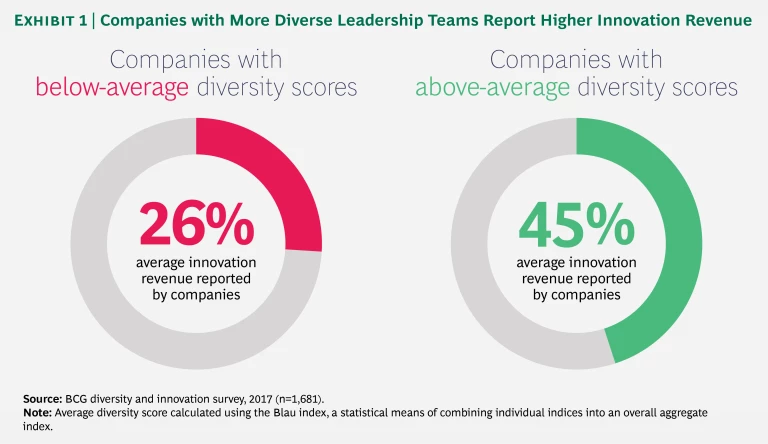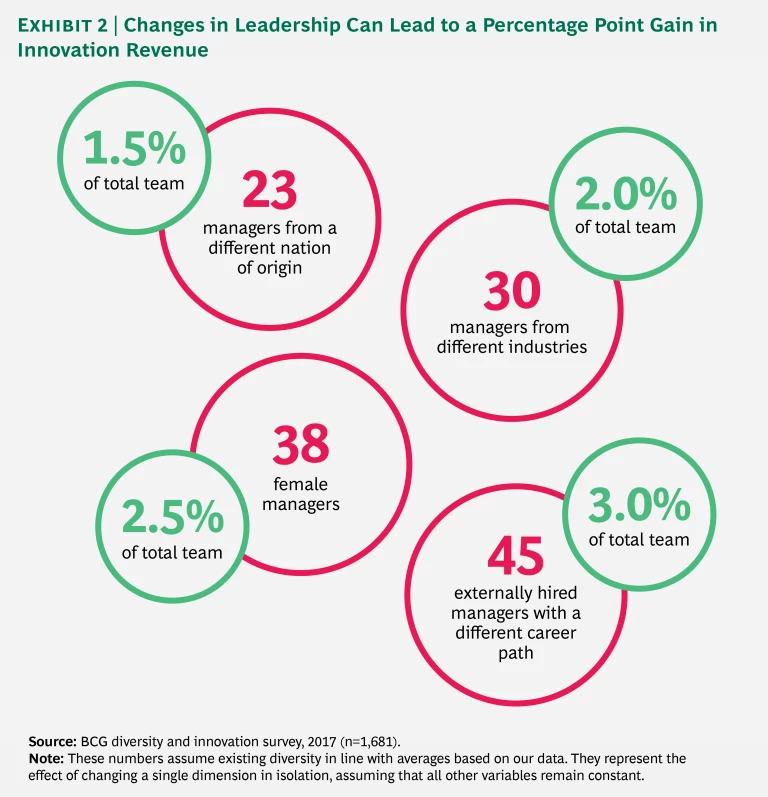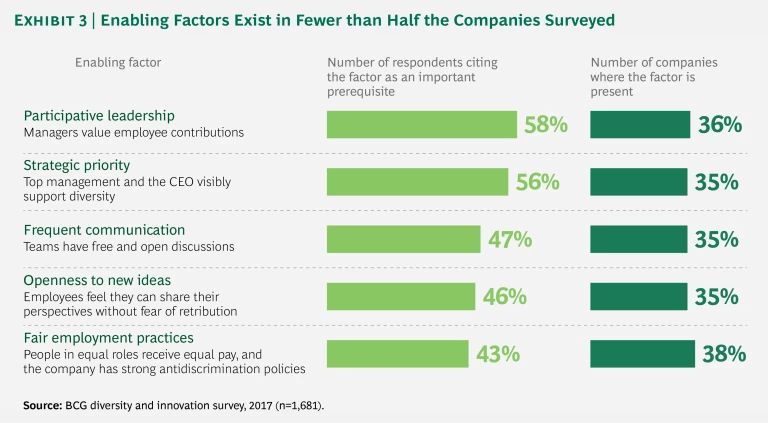“Hire a chief innovation officer.” “Change the culture.” “Look outside your industry.” There’s no shortage of advice about how companies can become more innovative. The catch is that most of that advice is based on anecdotal evidence. But there’s one step companies can take that does have some data behind it.
A recent BCG study suggests that increasing the diversity of leadership teams leads to more and better innovation and improved financial performance. In both developing and developed economies, companies with above-average diversity on their leadership teams report a greater payoff from innovation and higher EBIT margins. Even more persuasive, companies can start generating gains with relatively small changes in the makeup of their senior teams.
For company leaders, this is a clear path to creating a more innovative organization. People with different backgrounds and experiences often see the same problem in different ways and come up with different solutions, increasing the odds that one of those solutions will be a hit. In a fast-changing business environment, such responsiveness leaves companies better positioned to adapt. (See “ Diversity at Work ,” BCG article, July 2017.) This argument has always made intuitive sense, and now we have some convincing correlations to add to the case.
Diversity Gaining Momentum Worldwide
We surveyed employees at more than 1,700 companies in eight countries (Austria, Brazil, China, France, Germany, India, Switzerland, and the US) across a variety of industries and company sizes. (This was a followup study to one we reported on last year in The Mix That Matters: Innovation Through Diversity , BCG Focus, April 2017, and discussed in an accompanying TED talk .) We looked at perceptions of diversity at the management level across six dimensions—gender, age, nation of origin (meaning employees born in a country other than the one in which the company is headquartered), career path, industry background, and education (meaning employees’ focus of study in college or graduate school). To gauge a company’s level of innovation, we looked at the percentage of total revenue from new products and services launched over the past three years.

Broadly, 75% of respondents said that diversity is gaining momentum in their organizations. Employees at companies in emerging markets (China, Brazil, and India) reported greater progress over the past several years than companies in developed markets.
The biggest takeaway we found is a strong and statistically significant correlation between the diversity of management teams and overall innovation. Companies that reported above-average diversity on their management teams also reported innovation revenue that was 19 percentage points higher than that of companies with below-average leadership diversity—45% of total revenue versus just 26%. (See Exhibit 1.)
In other words, nearly half the revenue of companies with more diverse leadership comes from products and services launched in the past three years. In an increasingly dynamic business environment, that kind of turbocharged innovation means that these companies are better able to quickly adapt to changes in customer demand.
Not surprisingly, these organizations also reported better overall financial performance: EBIT margins that were 9 percentage points higher than those of companies with below-average diversity on their management teams.
Small Changes, Big Results
Of the six dimensions of diversity we considered, all showed a correlation with innovation. But the most significant gains came from changing the makeup of the leadership team in terms of the national origin of executives, range of industry backgrounds, gender balance, and career paths. Age and educational focus showed a lesser effect.
To see how diversity on the leadership team can translate into better financial performance, we looked at a hypothetical company with about 50,000 employees and 1,500 people in management roles. We started with a diversity mix in line with overall averages and innovation revenue that was about one-third of the company’s total (35%, the average for our sample of companies); we then changed each dimension in isolation to gauge the effect.

Relatively small changes in the makeup of management can have a significant impact. For example, if our hypothetical company were to hire 30 managers from a different industry (2% of the total management team), it would improve its innovation revenue by a full percentage point. Hiring 38 female managers (2.5% of the team) would have the same result, as would hiring 23 managers (1.5% of the team) from a country other than the one in which the company is based. (See Exhibit 2.) To be clear, these are not incremental new hires but rather replacements for existing managers and executives; the overall size of the management team remains the same, but it is more diverse.
Our research also found that the effects are additive for all dimensions aside from industry background and career path (which show some overlap). So rather than focusing on any specific aspect of diversity, the goal should be to create teams that are diverse across multiple dimensions—because they all have value.
Each company will need to find the right “mix that matters,” depending on its unique circumstances. The key message for leaders? Innovation may seem like a big, amorphous idea with an unclear path to success, but making relatively small changes can have a big impact.
Digitization as Rocket Fuel
The study also looked at the effect of digitization on overall innovation. We found that companies that place a greater emphasis on digital technology show an even stronger correlation between diversity and innovation.
Specifically, the study looked at how much companies invest in digital technology as a percentage of operating expenses. The findings were split into three categories: low (those in the 5th percentile), median (50th percentile), and high (95th percentile). Those in the highest percentile of digital investment showed the strongest correlation between diversity and innovation revenue.
So digitization provides a kind of rocket fuel to companies’ efforts to become more innovative. In other words, if a company invests in digital, the advantages of diversity accrue and position it to capitalize more effectively on those investments.
Subscribe to read our latest insights on Inclusive Advantage
Laying the Right Foundation
Even with a diverse management team in place, companies will be able to take advantage of the unique viewpoints and perspectives of leaders only if they have the right inclusive foundation. The study therefore looked at the presence of the factors that allow diversity to flourish and help the diverse management team reshape the company’s innovation efforts. These factors include fair employment practices, such as equal pay; participative leadership, with different views being heard and valued; a strategic emphasis on diversity led by the CEO; frequent and open communication; and a culture of openness to new ideas.

Most of the companies we surveyed fell short—fewer than 40% of respondents said that any of these characteristics describe their company, meaning there is significant room for improvement. (See Exhibit 3.) Notably, however, the companies where these conditions do exist report measurably higher innovation revenue—nearly 13 percentage points more than that of companies where the characteristics are weak or not present.
This is a familiar issue for organizations that try to improve diversity. It’s all too easy to hire people from diverse backgrounds and then sit back and expect the magic to happen. A passive approach is guaranteed to fail. (In fact, even active efforts don’t always succeed. BCG’s recent research on gender diversity shows that 91% of companies have a program in place, yet only 27% of women say they have actually benefited from it. See Getting the Most from Your Diversity Dollars , BCG report, June 2017.)
Many organizations have long-established cultures with a homogenous leadership team—primarily older white men who have risen through the ranks at their own company. They need to be proactive if they are to foster diverse viewpoints and perspectives. This requires a lot of time and attention, along with organizational changes that go far beyond the hiring process.
Specifically, companies need to approach diversity as they would any other business imperative. The CEO must own this agenda and visibly lead it. Success also requires accurately assessing the company’s starting point, establishing specific goals, and creating a roadmap with milestones and clear accountability. What is your target? How fast do you hope to achieve it? Who will implement it? And what are the consequences if an initiative falls short? These are the baseline components of project management, used in just about every major business program, and they are equally applicable to diversity initiatives—particularly given that success can have such great rewards.
There has long been anecdotal evidence supporting the idea that diversity fosters innovation. Now there is a databased case as well. The evidence is clear: companies that take the initiative and actively increase the diversity of their management teams—across all dimensions of diversity and with the right enabling factors in place—perform better. These companies find unconventional solutions to problems and generate more and better ideas, with a greater likelihood that some of them will become winning products and services in the market. As a result, they outperform their peers financially. For management teams, there are few slam dunks in the business world. This is one of them.







